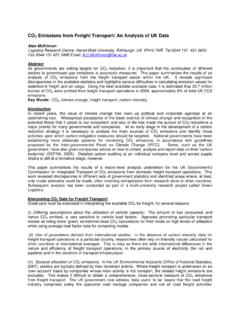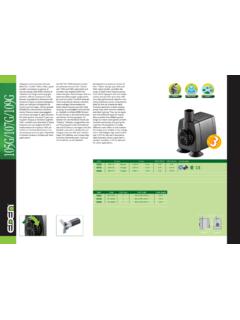Transcription of The impact of failed home deliveries on carbon …
1 The impact of failed home deliveries on carbon emissions: Are collection / delivery points environmentally - friendly alternatives ?Julia Edwards1;Alan McKinnon1;Tom Cherrett2;Frazer McLeod2; Liying Song31 Logistics Research Centre, Heriot-Watt University, UK2 Transport Research Group, Southampton University, UK3 School of Traffic and Transportation, Beijing Jiaotong University, ChinaPhenomenal growth in online shopping billion spent online in the UK in first half of 2009 (IMRG) 69% of shoppers now shop from home (National Statistics ) >11m Britons shop from home at least twice a week ( ) 820 million parcels delivered in 2008 (IMRG)UK households with internet access(Source: National Statistics, 2009)Online shopping: Is it environmentally - friendly ?Consumers seem to think shoppers give home shopping is good for the environment an average score of 6 out of 10 Do you think that online shopping is more planet- friendly than shopping on the high street?
2 Yes 56%No 44%Evening Standard, 20 June 2007 The Guardian, 12 September 2007 Online shopping: Is it environmentally - friendly ?Some retailers seem to claim I ve been internet shopping We called while you were outWE TRIED TO DELIVERBut then there is the dreaded failed delivery : the consequences Anyone who believes that time is merely an abstract concept, never waited in all day for a The customer is inconvenienced; The carrier incurs additional costs; There are wider environmental impacts,owing to additional vehicle aims of this studyTo assess (on a per drop basis):1. Additional gCO2produced when a failed parcel requires re- delivery by the carrier; 2. Additional gCO2produced when a customer travels to the local depot to collect an undelivered order;3. gCO2savings from the use of alternative collection / delivery points (C/DPs).
3 Consumer concerns re. home deliveryWhat is the most frequent reason deliveries are not successful on the first attempt?Is there normally someone at home to receive deliveries in the daytime?NO 25%YES 75%Do delivery concerns ever prevent you from shopping online?NO 69%YES 31%Have you ever had an inconvenient delivery ?NO 65%YES 35%Research Aim 1: delivery failure rateFirst-time delivery failure rate: assumptionsafter Weltevreden & Rotem-Mindali (2008) & IMRG (2008)after McLeod & Cherrett (2006), Song et al. (2009) & Belet et al. (2009)after Retail Logistics Task Force (2001) 10%30%50%50%Second-time re- delivery failure rate: assumptionsafter McLeod & Cherrett, (2009) YES 84%NO 16%Would you be happy for a neighbour to sign on your behalf?Successful first-time delivery : Emissions for an average non-food home delivery * Average values, calculated from 4 sources: Defra; NAEI; FTA; RHACO2per drop181gAssumptionsRound trip (miles)Drops per roundItems per drop501201 failed delivery : Emissions (gCO2) per itemHome delivery181g199g235g100% successful first-time delivery10% failure rate30% failure rate50% failure rate271gFirst-time delivery failure as a delivery for which a signature cannot be obtained, either from the customer or a designated customer representative, & this results in the customer's address being carded & the item returned to the delivery depot for either redelivery or customer collection .
4 (IMRG, 2008)Re- delivery factoring in a 50% failure rate: Emissions (gCO2) per dropFirst delivery attempt failure rate(plus 50% 2nddelivery failure)10% failure rate30% failure rate50% failure rategCO2per drop% increase over base case208g15%262g45%316g75%And when the 2nddelivery attempt a delivery fails, how long does it take you to collect an item?Distance to local depot & trip chaining: Research assumptionsafter Clements (2005)after McLeod & Cherrett (2009) after Song et al. (2009) 15km25km40km50%distance allocated to collection of failed delivery (realistic assumption) Aim 2: Emissions (gCO2) per consumer trip to a local depot to collect an undelivered orderDistance to local depot15km25km40kmCarBus3,113g1,340g5,188 g2,234g8,300g3,574ggCO226 re- delivery attemptsResearch Aim 2: Emissions (gCO2) per delivery & consumer trip to a local depot (%) delivery {{ delivery {{Assumes:30% of first-time failed deliveries fail and 50% of second delivery attempts also fail.}}}}
5 A customer travels 25-km to a local depot to collect an undelivered orderFailed delivery (262gCO2) collection by CAR from parcel depot (5,018gCO2)+ failed delivery (262gCO2) collection by BUS from parcel depot (2,234gCO2)+Alternative collection / delivery locations (C/DPs)Where would you be likely to choose?Local newsagentPetrol stationConvenience storeSecure box near where you liveOtherYES 40%NO 60%Would you opt for a delivery location option of your own choice?Research Aim 3:Location, distance & advantages of C/DPsTesco ExtraOther supermarketAverage supermarketPost officeRailway opening times, familiarity, regular destinationExtended hours, proximity, regular destination24-hr / extended hours, regular destinationProximity, familiarity, regular destinationConvenient for rail users / daily commutersLocationDistance (km) from av.
6 Consumer s homeAdvantagesResearch Aim 3:Emissions savings (%) per consumer trip to alternative C/DPs versus traditional deliveryTesco ExtraOther supermarketAverage supermarketPost officeRailway station204186195185192 LocationCO2per av. drop (incl. additional km to C/DP)CO2for consumer trip to C/DPs1,349g332g830g249g664g581g143g357g1 07g664gCarBus% CO2per C/DP compared with traditional delivery47%16%31%13%26%Conclusions1. Additional CO2from the second delivery attempt increased the emissions per drop by between 9 -75%. 2. Vast majority of emissions associated with traditional failed delivery arise from the personal trip to the local depot. (Worst case scenario equivalent to 26 re- delivery attempts by delivery van).3. Supermarkets, railway stations & post offices each offer distinctive benefits for consumers, & all lessen the CO2emissions from failed home deliveries .
7 (Post offices, owing to their extensive network, present the greatest savings).Logistics Research CentreHeriot Watt UniversityEDINBURGH, details











